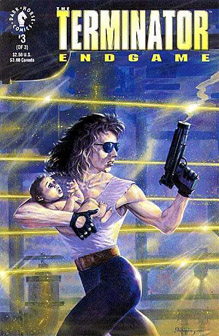Dark Horse closes out its “1984 saga” with the deliciously hardboiled three-issue “Endgame”(1992). Artists Jackson Guice (pencils), John Beatty (inks) and Gregory Wright (colors) are a perfect complement to the writing of James Robinson (“One Shot,” “Secondary Objectives”) with their loads of shadows, panels “shot” from above ceiling fans, and one page of a bunch of small panels showing chain-smoking Detective Sloane making the dozens of phone calls needed to solve a serial-killer case.
About to give birth to John on Oct. 4, 1984, in Odessa, Texas, Sarah Connor is central to the story yet her only appearances are in a sequence of “giving birth” panels in Issue 3. It calls to mind those later-season “X-Files” episodes where Mulder is central to the story but we keep waiting for him to actually appear. Ultimately, I don’t mind that Sarah isn’t the main character of Dark Horse’s 1984 arc, because Mary, Sloane and Dudley deepen the “Terminator” mythology.
Issue 3 shakes up everything we thought we knew about the rules of time travel and “Terminator” timelines – for better or worse. Even if you go with “worse,” “Endgame” is a fun ride.
CHARACTERS
John Connor: On the verge of being born, or so we think.
Sarah Connor: We think she’s about to give birth to John on Oct. 4, 1984, in Odessa, Texas, but she has a girl, Jane, instead. As with “Secondary Objectives,” there’s some cover confusion here: Issue 3 appears to show Sarah running with her baby in her arms, but it could be Mary. At any rate, the sequence doesn’t occur in the story.
Kyle Reese: Dead during this time, as per the events of the movie.
Jane Connor: The child – and future resistance leader — who Sarah actually gives birth to.
Mary Randall: She convinces Sloane to kill FBI Agent Lockhurst and destroy the T-800 schematics. But the missing Dudley is a loose end on her mission, so she tracks him down in San Diego, where he tells her about the T-800’s upcoming attack on Sarah in Odessa.
Detective Sloane: A classic hardboiled detective, he kills Lockhurst for Mary but then says he wants nothing more to do with her. He then becomes embroiled in a string of serial killings. Like Sarah Connor in “T2,” he talks to a psychiatrist (who thinks Sloane is nuts) about Terminators; the difference is that Sloane does so voluntarily.
FBI Agent Lockhurst: He’s mulling what to do with the T-800 schematics when Sloane kills him.
TERMINATORS
Dudley: Although Ed Astin (who doesn’t appear in this series, and presumably did indeed die in “The Enemy Within”) stole the T-800 schematics from Dudley’s brain, that didn’t kill Dudley’s Terminator half after all. He continues to fight his evil half in this series. But it does prove useful: He receives information about the Canadian T-800’s mission to Odessa, and informs Mary.
The Canadian Terminator: Skynet sends one last T-800 to fight it out in 1984, with the specific mission of killing the pregnant Sarah Connor (or the infant John Connor, depending on the timing). It’s the last thing Skynet does before it is destroyed in 2029, and it has to use a TDE facility in the Northwest Territories of Canada because the Los Angeles facilities had been destroyed in “The Enemy Within.”

CONTINUITY
“Endgame” is the final chapter of Dark Horse’s 1984 quadrilogy, which also comprises “Tempest,” “Secondary Objectives” and “The Enemy Within.”
On the final page, Sarah gives birth to Jane Connor rather than John Connor. This raises a couple of questions: First, does an instance of time travel lead to an alternate timeline? If the answer is yes, then one alternate timeline features Jane Connor as the resistance leader. Robinson seems to play it as an alternate timeline with the closing line: “And in THAT future, Jane Connor leads her troops to victory.”
If we stick with the idea of one timeline that gets overwritten (which is how the majority of “Terminator” storytellers – and therefore the characters and machines – approach the concept of time), the question becomes: In what order do the timelines occur?
If we decide the Jane Connor saga is newer than the John Connor saga, that puts us in the awkward position of knowing that all the “Terminator” stories that came out since “Endgame” chronicle a defunct timeline. If we decide all of the John Connor comics, movies and TV episodes are on a newer timeline than the Jane Connor saga, that puts us in the awkward position of requiring an additional story that’s the opposite of “Endgame”: One where Sarah expects to give birth to a girl, but instead has a boy.
The Cyberdyne saga also leads to an “alternate timelines” vs. “one true timeline” debate. In “Endgame,” Mary and Sloane kill Lockhurst and destroy the last of the future technology, closing the book on this thread. Yet 11 years later in “T2,” Dyson has access to the arm and microchip that were destroyed in this comic-book saga.
There are four possible explanations: 1) “T2” and the Dark Horse 1984 saga exist on an alternate timelines, made possible by an instance of time travel, 2) “T2” does continue from Dark Horse’s 1984 saga, but we haven’t seen the story explaining that the arm and microchip were not destroyed after all, 3) The 1984 saga has overwritten the “T2” saga, which means all “Terminator” stories released since “Endgame” chronicle a defunct timeline, or 4) The “T2” timeline has overwritten the 1984 saga timeline due to an instance of time travel we don’t know about (perhaps the same one where it turns out Sarah gives birth to a boy after all).
Out of these myriad possibilities, I’m most comfortable with the idea that an untold story led to the “T2” timeline (with John and Dyson) overwriting the 1984 saga timeline (with Jane and Hollister/Astin/Lockhurst). But it’s just a matter of taste.
TIME TRAVEL
One last T-800 emerges as part of Dark Horse’s 1984 saga. In the 2029 portion of the story, all of Skynet’s Los Angeles TDE facilities had been destroyed, but it also had a facility in the Northwest Territories of Canada. Skynet is able to send one last T-800 through the Canadian TDE just before the resistance forces pull its plug.
This is reminiscent of how Skynet sends back the T-1000 just before Skynet’s death, as chronicled in the novelization of “T2.” That was at the prototype L.A. TDE facility (already destroyed by the time of “Endgame”), which creates a contradiction with Dark Horse’s saga, where the war continues for at least three more months after the destruction of the prototype facility.
The explanation might be this: Both are last-ditch strategies. Skynet sent back the T-1000 when it THOUGHT it was going to die. Skynet later sends back the Canadian T-800 in a true last-ditch effort. The T-800’s mission is to kill John Connor as an infant on his birthday of Oct. 4, 1984, working from Skynet’s brand-new knowledge of John’s birthplace: Odessa, Texas.
As a side note, the reason for the three-month gap between when Skynet thinks it is going to be destroyed and when it actually is destroyed could be explained by “Hunters and Killers.” Perhaps it’s right after the T-1000 time-jumps that the U.S. resistance realizes it needs to destroy Mir before it pulls the plug on Skynet. So Mir is destroyed in “Hunters and Killers,” then the U.S. resistance kills Skynet for good.
Evidence for “fate”:
- Sarah gives birth to her child – the future resistance leader — on Oct. 4, 1984 in Odessa, Texas, which is consistent with the previous history.
- While Sloane and Mary aren’t in Odessa to stop the Canadian T-800 in the new timeline that comes about after the T-800 winks out of existence, they are still in Odessa rather than L.A. This might be because fate drew them there for other reasons – maybe just a feeling that they needed to protect Sarah.
Evidence that “the future is not set”:
- Sarah’s child is Jane Connor, not John Connor.
- Ironically, Skynet’s Odessa knowledge is made possible by the success of Mary, Sloane and Dudley in wiping out all the future technology and its adherents (Hollister, Astin and Lockhurst) – this “delayed the machines’ evolution.” In this comic saga’s timeline, the resistance “began fighting back earlier,” the war never reached Texas and the records of John’s birth in Odessa weren’t destroyed. So Skynet now has this information and takes advantage of it via the Canadian T-800’s last-ditch mission. “Endgame’s” sequence of causal determination demonstrates that “the future is not set” in part because the PAST is not set.
- “Endgame” Issue 3 features the saga’s first portrayal of time shifting before our (readers’) very eyes. A 1984 variable changes (Mary erases the record of Sarah’s hospital visit), causing a 2029 variable to change (Skynet does not send back the Canadian Terminator because it does not know John is born in Odessa), and thus causing a 1984 variable to change (the Canadian Terminator winks out of existence). He doesn’t disappear at the very moment Mary erases the hospital record, but rather a few minutes later. Apparently even the gods of time need a bit of time to make the appropriate adjustments. Then we get what I’d call a stylized portrayal of time shifting: Sloane and Mary experience brief amnesia, unaware of their location or their reason for being there. My guess is their new memories will quickly flood into their brains. So why are they in Odessa, if not to stop the Canadian Terminator? The most likely answer is that they are protecting Sarah just in case.

